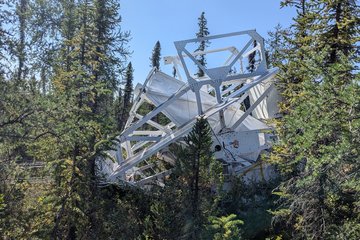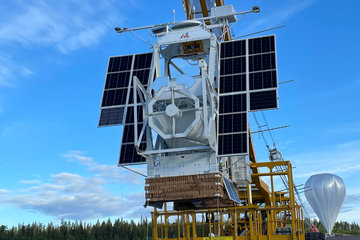In the realm of eternal ice
Celestial bodies made up of frozen water orbit not only at the outer limits of our solar system but also further inside.

Dwarf with a moon: This artist’s impression shows Eris and its moon Dysnomia. The bright star on the right is our Sun.
Text: Thorsten Dambeck
On 6 November 2010, the light of the star known as NOMAD1 0856-0015072 in the Cetus constellation dimmed. What had happened? A dwarf planet at the edge of the solar system had moved in front of the distant star - its name: Eris. Such a “stellar eclipse” affords astronomers a rare opportunity to find out more about the icy worlds which circle the Sun en masse beyond Neptune’s orbit.
Eris is not very popular with dyed-in-the-wool Pluto fans, as it was ultimately its discovery which expelled Pluto from the family of large planets in 2006. Some years before that, astronomers had tracked down the first, albeit smaller members of Eris’ type in the so-called Kuiper belt; the first one was captured in 1992.
Well over a thousand objects orbit in the tyre-like outer zone of the solar system and fill today’s astronomical catalogues. These range from miniature rocks the size of a tower block through to large dwarf planets such as Eris, measuring thousands of kilometres. The total mass of the Kuiper belt is estimated to be around 0.1 terrestrial masses – considerably more than in the main belt of the asteroids between Mars and Jupiter.
What these distant, very icy bodies look like is not yet known. In a telescope, they are merely unstructured spots of light - even with the highest magnification. The race to obtain the first portrait photo of such a dwarf world has meanwhile been won by Dawn – with an object whose orbit is much closer to the Sun: the image of Ceres was taken by the space probe’s onboard cameras, the so-called Framing Cameras, which originate, however, from the Max Planck Institute for Solar System Research in Göttingen.
The fact that icy bodies should exist relatively close to the Sun was surprising, according to Andreas Nathues. “But Ceres’ low average density cannot be explained in any other way than by a high proportion of water,” says the Max Planck researcher. Other bodies, such as the asteroid Themis – whose diameter of around 200 kilometres makes it significantly smaller than Ceres (equator diameter: 974 kilometres) – turned out in recent years to be at least partially covered with ice.
Dawn had already visited the Vesta asteroid four years ago – a rocky world, very probably without any ice. What differences do the two asteroids exhibit from the perspective of the onboard cameras? “The seven colour filters of the Framing Cameras provide us with a very sensitive measuring instrument for the spectral differences,” says Nathues. “And these are considerable. Vesta’s surface is much brighter than Ceres’ surface for the most part and has strong absorption lines at a wavelength of around 1000 nanometres, while Ceres has a steep drop in the violet and ultraviolet light below 450 nanometres. The corresponding drop in brightness with Vesta is much more moderate.”
What causes this so-called UV drop-off with Ceres must still be brought to light by further analyses. The indications that it consists partly of ice become particularly clear if the images of Ceres are looked at through the eyes of a geologist. These images show comparatively young landscapes, for example the walls of some impact basins that have become significantly flatter throughout geological ages.
“The material is possibly similar to that of terrestrial glaciers which flow down a slope. This is a strong indication for a viscous material that very likely acquires its properties because the ground consists partly of ice,” says Nathues.

Relic from birth: The Kuiper belt is considered to be the largest known structure from the nascent phase of the solar system – a flat, annular accumulation of around 100,000 objects measuring at least100 kilometres and countless smaller pieces of debris. The illustration shows the orbit of the outer planet (Pluto's orbit is yellow) and the flight route of the space probe of New Horizons (red).
The spatial distribution of ice was a key factor in the formation of the celestial bodies of the solar system. In general, the raw material for the formation of planets originates from large molecular clouds containing gas and dust. In greatly simplified terms, the gas – mainly hydrogen – is the raw material for the star which is formed when the masses of gas collapse. Planets stem from protoplanetary disks that form around young stars in these molecular clouds.
The astrophysicists are largely in agreement that gaseous planets such as Jupiter form relatively quickly, meaning within only a few million years. They obtain the gas they need from this protoplanetary disk. The birth of rocky planets, such as Earth, takes considerably longer, however. The dust is the most important ingredient for this process: it collects initially in micrometre-sized particles, although the particles quickly grow.
If the objects are a few kilometres in size, gravity provides further growth: a competition ensues as to which object can increase its mass the most, whereby only the fastest bodies finishing as fully grown planets. The innumerable losers of this process are swallowed up by the small numbers of winners.
But even the early phase of this process is a puzzle for the theoreticians, in respect of both the gaseous and the rocky planets, as the formation of the centimetre-sized aggregates is only partially understood. At the high collision speeds, more particles should actually be destroyed than larger ones aggregate.
The volatile substances – water, for example – probably play their part in overcoming this growth brake, according to Paul Hartogh. The Göttingen-based Max Planck researcher heads the “Water in the solar system” research focus of the Herschel space telescope belonging to the European space organisation ESA. “Close to the star, water in a protoplanetary disk is gaseous. Further out, where the disk is cooler, a so-called frost line forms, which means from there upwards the water molecules freeze to become ice,” says Hartogh.
The ice deposits on the dust grains of the disk and provides them with a sticky coating. This results in the evolving planets growing at a faster rate, as the icy glue now makes it more difficult for the dust grains to break up during the collisions. In addition, the ice increases the proportion of solid material in the disk, another growth factor.
The reality is somewhat more complex than this clear picture, however, because other volatile substances that play a special role in the formation of the solar system have their own frost lines which are each at different distances from the Sun. Moreover, as is the case in politics, the lines are not for eternity: “The frost lines have shifted during the formation history of the solar system,” says Hartogh, with respect to the variations in the thermal output of the Sun.
US astronomers from the University of Michigan also found water ice at other locations in the universe. They and their colleagues recently presented their analyses of the infrared data from Herschel. The scientists reported finding water ice in the outer regions of the disk around three young, so-called T-Tauri stars. They were the first to discover the signature of ice in the protoplanetary disks around these early phases of Sun-like stars with the help of the ESA satellite, which is specially equipped to search for water. “Herschel’s spectral measurements possibly reveal a kind of early version of the Kuiper belt,” says Hartogh.

Returning to our local Kuiper belt: stellar eclipses are the best way of determining the size of dwarf planets. No less than three telescopes were able to record the sudden drop in brightness during that night in November 2010 when Eris eclipsed the Cetus star. The analysis showed: Eris is almost spherical, its diameter is 2,326 kilometres – in this respect it is virtually a twin of Pluto.
As Eris is orbited by its moon Dysnomia, astronomers can compute the mass of the dwarf planet from its orbit. This, together with the dimensions from the stellar eclipses results in the average density: at 2.5 grams per cubic centimetre it is significantly higher than for Pluto and Ceres (both around 2.0).
Comparing both, Eris obviously contains more heavy rock and less light ice. The densities of other, larger Kuiper objects – and thus their internal structures as well – cover a considerable range. And this will hardly be the last surprise for those investigating the icy worlds of our solar system.














